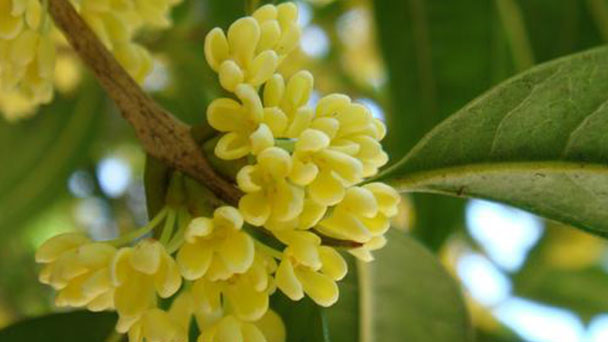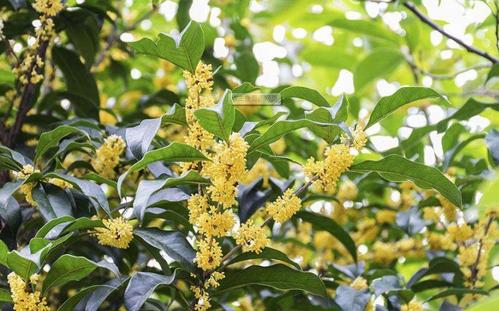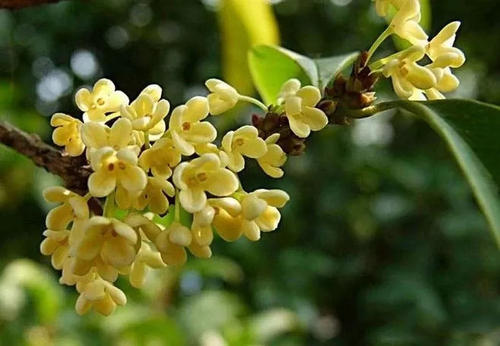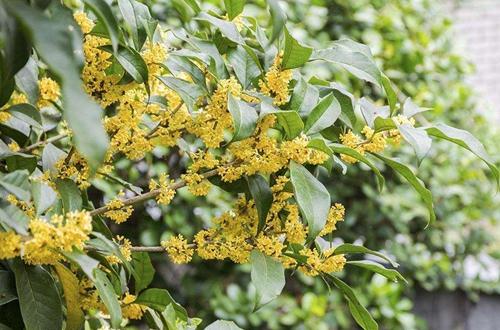How to grow and care for Sweet Osmanthus
Written by Maggie
Oct 19 2021

Sweet osmanthus is cultivated in both Japan and India. Since 1771, Sweet osmanthus from China was introduced to Britain through Guangzhou and India, and then expanded rapidly. Nowadays, it is widely cultivated in many European and American countries as well as Southeast Asian countries, becoming an important fragrant flower plant. How do you grow and care for the Sweet Osmanthus tree? Let's see together.

Growing Sweet osmanthus
Collection and treatment of seeds
When we grow Sweet osmanthus, dark purple, plump seeds are collected from the large Sweet osmanthus tree or ground, usually in May or June. Post-harvest treatment: Rub the seed with sand to remove the seed coat, and use water to remove the empty seed coat floating above.
Seed storage
The seeds removed from the seed coat need to be buried in sand for a long time and germinate when they are fully mature. Seeds can be buried in the wet sand, stored in the water tank, with glass sealing moisturizing, storage process to do sand moisturizing, sand storage needs to maintain one-tenth of the water, in the late to ensure half of the water.
Sowing time and requirements
In March of the following year, when the seeds are out of the bud, a drill can be planted. The seeds should be covered with grass to keep them in shade. That year, sweet osmanthus seedlings grew to more than 16 centimeters. After two years of cultivation, seedlings are replanted the following spring, and flowering is expected within ten years.
Growing Sweet osmanthus on the balcony
When we grow Sweet osmanthus on the balcony, choose the young plant most suitable. 30 ~ 50 cm high young plants will first put a layer of 4 cm thick gravel pot spread, and the bottom of the pot drilled a few holes (to facilitate water), and then put the pot on the gravel above. Then fill the pot with fine soil and plant Sweet Osmanthus plants. After planting the plants, cover the roots 4 to 5 centimeters thick with fine soil and pat the soil tightly. Finally, soak the pot soil with the root water. When the seedling plant is alive and shows the new bud, pry open the soil at the root, and apply 100 grams of fermented oil cake according to each plant. Three months later, 100 grams of ammonium bicarbonate can be used per plant to 500 grams of fecal water once, and it is advisable to apply less and more frequently later.
Growing Sweet osmanthus in the garden
①50 ~ 100 cm high seedlings, nest cultivation. The depth of the nest is 40 cm and the width of the nest is 50 cm. After the nest will be the nest mud Sweet Osmanthus tree photo collection (14) soil is not fine. Then cultivation, after growing seedlings covered with fine mud 7 ~ 10 cm thick.Then pat the soil firmly, and finally drench the soil in the nest with root water. (2) the large plant is more than 100 cm, the nest cultivation. The depth of the nest is 60 cm and the width is 80 cm. The soil in the nest is still not fine after playing the nest, and then cultivate the seedlings, after planting the seedlings, cover the soil 10 ~ 15 cm, and then pat the soil tightly, and still (with clear water) drench the root water will soak the soil in the nest. To be large, small seedling strains survive to show the new bud according to each plant of human and animal dung urine 1 kg drench once. Three months later, 1 to 2 kg of fecal water was drenched with 150 grams of ammonium bicarbonate per plant. Then do the application, less application is appropriate.

Growing Sweet osmanthus care
1. Sweet Osmanthus likes slightly acidic soils. When we grow and care for Sweet osmanthus, potted can choose mountain mud or saprophage soil 5, garden soil 3, sandy soil 2 mixed modulating or humus soil and sandy loam soil each half for cultivation soil.
2. Watering should be timely. When we grow and care for Sweet osmanthus, watering to master the "two less one more", that is, before the new shoot occurs less watering, rain water less watering, summer and autumn dry weather need more watering. Watering at ordinary times to often maintain the pot soil about 50% moisture content is appropriate. Especially when autumn flowering, if the soil is too wet, it is easy to cause falling flowers. Overcast rainy days should pay attention to check. If there is water in the basin, it is necessary to pour water in time to avoid long time caused root rot.
3. Skillfully apply top dressing. Sweet Osmanthus sprouts in the spring about every 10 days after applying a fully ripe thin pancakes fertilizer water, to promote germination and branches. After July, thin decaying chicken and duck dung water or fish mixed water or 0.5% superphosphate was added to the fertilizer solution to promote germination and differentiation. When the last phosphate-based liquid fertilizer was applied in early September, Sweet Osmanthus flourished, bloomed and smelled good. When we grow and care for Sweet osmanthus, if there is not enough fertilizer, especially phosphate, there are fewer branches, fewer flowers, and no fragrance.
4. Proper trim. Sweet osmanthus trees have developed roots and strong germination. Adult Sweet Osmanthus trees shoot twice a year in spring and autumn. Therefore, in order to make Sweet osmanthus flourish, proper pruning is needed to maintain the physiological balance of reproductive growth and nutritional growth. So when growing and caring for Sweet osmanthus, you need a pruning after the fall bloom. According to the plant growth potential, in addition to the dense branches of sparse cut outside, but also the summer and autumn long branches cut, make each side branch evenly left stubby short branches. A second pruning was done before the bud in early spring, cutting off orange, weak, and diseased branches to allow for more ventilation and light, and to encourage Sweet Osmanthus to produce more and fuller buds. During the growing period to often cut off the bud branches, for the sake of flower concentration, it is flourishing. In addition, potted Sweet Osmanthus should be planted with short and strong plants, compact branches and leaves, and thick trunk. Repot every 1 to 2 years in early spring. In northern China, Sweet osmanthus should be moved to cold rooms above 0℃ for winter in late autumn to keep the soil slightly moist and make it fully dormant, which is conducive to flowering in the next year. In the next year, Sweet osmanthus should be moved to outdoor ventilated sunny places for conservation after Tomb-Sweeping Day.
5. Pest control. Sweet Osmanthus is often prone to anthrax, brown spot, gray paste disease, blight spot, algal spot, soot disease and black thorn mealthopper, scale insect, moth, thorn moth, grass cicadas, Sweet Osmanthus leafhopper and other diseases and pests. When we grow and care for Sweet osmanthus, it is necessary to spray control in time.

Read Next:
How to Propagate Sweet Osmanthus
Sweet Osmanthus Profile
Latest Updated
- Benefits of Bugleweed - 7 Science-backed Health Benefits
- Bugleweed Dangers & Side Effects - Is It Poisonous?
- How to Plant Evergreen Trees - What You Should Know
- When to Plant Evergreens - Grow Guide for Evergreen Trees
- 12 Wonderful Evergreen Shrubs for Your Garden
- 12 Popular Evergreen Plants with Pictures for Beginners
- When And How To Prune A Lilac Bush Like a Pro
- How to Grow & Care for Lilac Vine (Hardenbergia Violacea)
- Japanese Lilac Tree (Syringa Reticulata) Care & Propagation Guide
- Shumard Oak Pros and Cons - What to Know
Popular Articles
- Winter maintenance of Antirrhinum Majus
- How to Grow Terminalia Mantaly Tree
- How to Grow and Care for Crossostephium Chinense
- How to grow Antirrhinum Majus in spring
- Peristeria Elata (Dove Orchid) Profile: Info & Care Guide
- Underwatered Snake Plant (Sansevieria Trifasciata) - Signs And How To Fix
- How to Care for Brazilian Jasmine Plant (Mandevilla Sanderi)
- How to Grow & Care for Graptopetalum Purple Delight in Summer
- Rosa Chinensis (China Rose): Plant Growing & Care Tips
- How to Care for Baby Sun Rose (Aptenia Cordifolia)